University Finance Assignment: Investment and Bonds Analysis
VerifiedAdded on 2020/05/28
|14
|3168
|188
Homework Assignment
AI Summary
This finance assignment comprehensively addresses key concepts in finance, including bond valuation, portfolio analysis, and investment strategies. Question 1 focuses on retirement planning, calculating nominal rates of return, determining retirement income needs, and assessing the impact of property purchases on retirement funds. Question 2 delves into bond valuation, calculating bond prices under various market conditions and exploring the relationship between maturity and price. It also recommends bond purchases based on interest rate forecasts. Question 3 analyzes stock returns, calculating expected returns and risks for four stocks and portfolios. It explains correlation's impact on portfolio risk, discusses diversification, and recommends a portfolio for a risk-averse investor. The assignment utilizes financial calculations, data analysis, and critical thinking to provide a thorough understanding of financial principles and investment strategies.
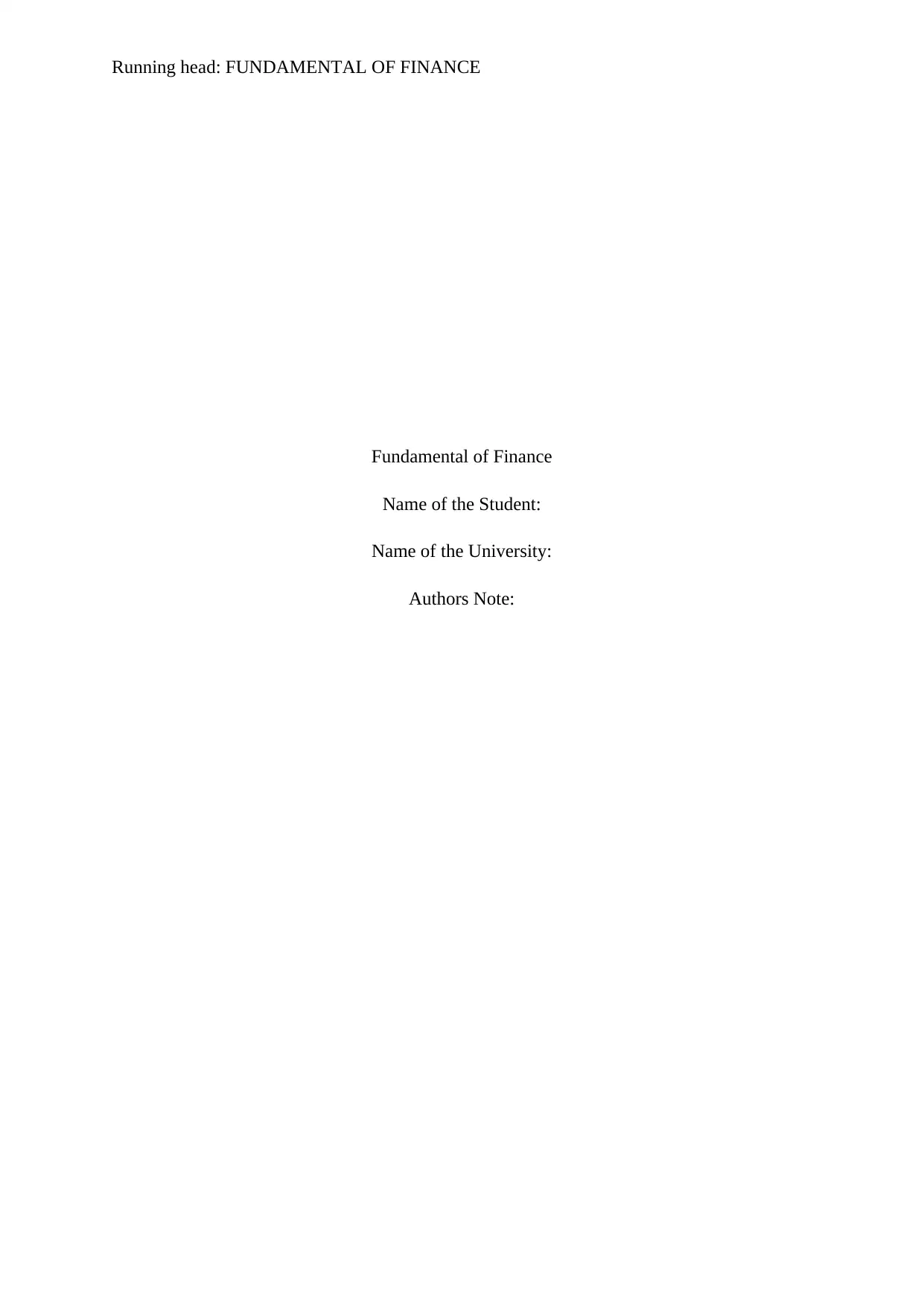
Running head: FUNDAMENTAL OF FINANCE
Fundamental of Finance
Name of the Student:
Name of the University:
Authors Note:
Fundamental of Finance
Name of the Student:
Name of the University:
Authors Note:
Paraphrase This Document
Need a fresh take? Get an instant paraphrase of this document with our AI Paraphraser
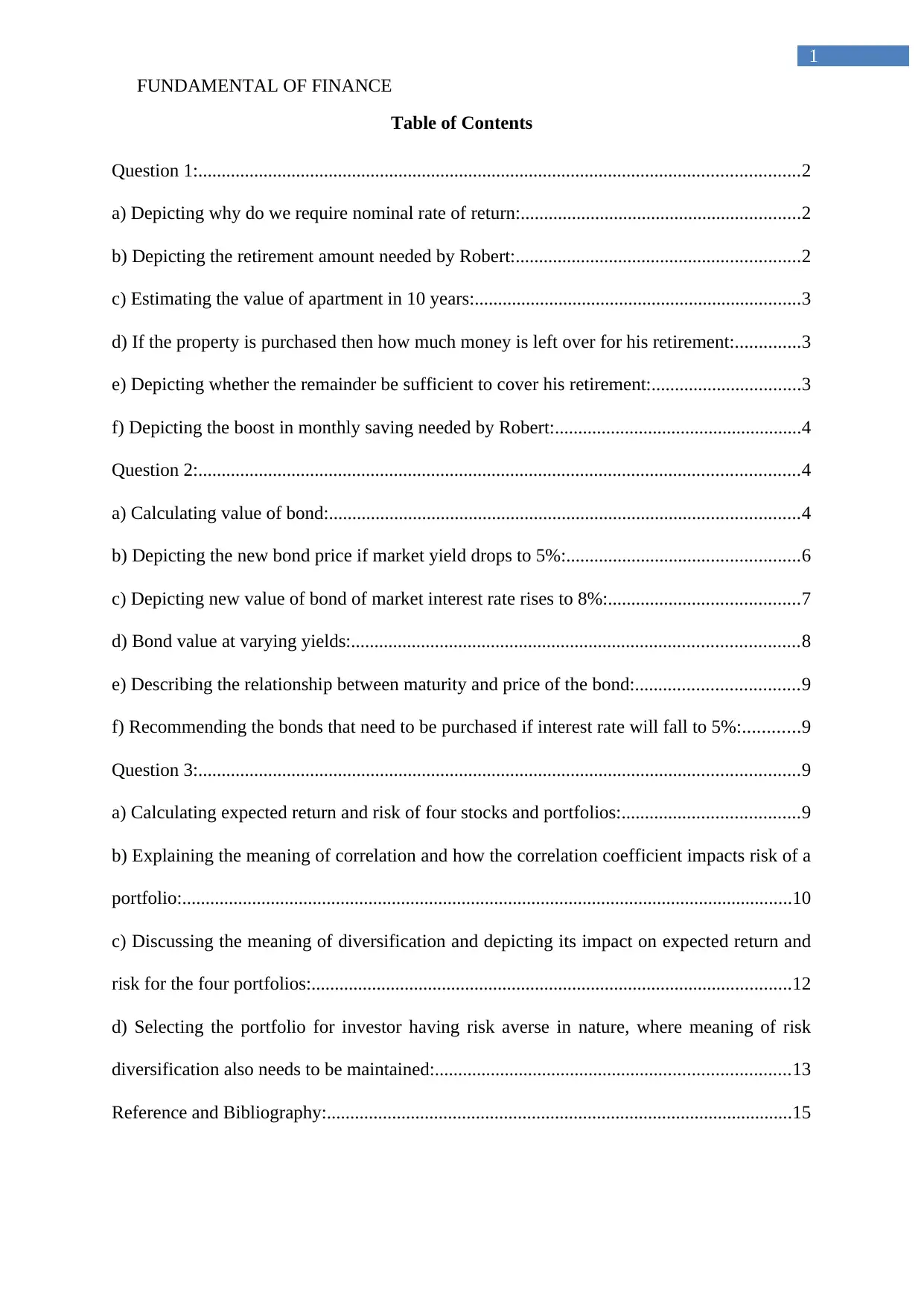
FUNDAMENTAL OF FINANCE
1
Table of Contents
Question 1:.................................................................................................................................2
a) Depicting why do we require nominal rate of return:............................................................2
b) Depicting the retirement amount needed by Robert:.............................................................2
c) Estimating the value of apartment in 10 years:......................................................................3
d) If the property is purchased then how much money is left over for his retirement:..............3
e) Depicting whether the remainder be sufficient to cover his retirement:................................3
f) Depicting the boost in monthly saving needed by Robert:.....................................................4
Question 2:.................................................................................................................................4
a) Calculating value of bond:.....................................................................................................4
b) Depicting the new bond price if market yield drops to 5%:..................................................6
c) Depicting new value of bond of market interest rate rises to 8%:.........................................7
d) Bond value at varying yields:................................................................................................8
e) Describing the relationship between maturity and price of the bond:...................................9
f) Recommending the bonds that need to be purchased if interest rate will fall to 5%:............9
Question 3:.................................................................................................................................9
a) Calculating expected return and risk of four stocks and portfolios:......................................9
b) Explaining the meaning of correlation and how the correlation coefficient impacts risk of a
portfolio:...................................................................................................................................10
c) Discussing the meaning of diversification and depicting its impact on expected return and
risk for the four portfolios:.......................................................................................................12
d) Selecting the portfolio for investor having risk averse in nature, where meaning of risk
diversification also needs to be maintained:............................................................................13
Reference and Bibliography:....................................................................................................15
1
Table of Contents
Question 1:.................................................................................................................................2
a) Depicting why do we require nominal rate of return:............................................................2
b) Depicting the retirement amount needed by Robert:.............................................................2
c) Estimating the value of apartment in 10 years:......................................................................3
d) If the property is purchased then how much money is left over for his retirement:..............3
e) Depicting whether the remainder be sufficient to cover his retirement:................................3
f) Depicting the boost in monthly saving needed by Robert:.....................................................4
Question 2:.................................................................................................................................4
a) Calculating value of bond:.....................................................................................................4
b) Depicting the new bond price if market yield drops to 5%:..................................................6
c) Depicting new value of bond of market interest rate rises to 8%:.........................................7
d) Bond value at varying yields:................................................................................................8
e) Describing the relationship between maturity and price of the bond:...................................9
f) Recommending the bonds that need to be purchased if interest rate will fall to 5%:............9
Question 3:.................................................................................................................................9
a) Calculating expected return and risk of four stocks and portfolios:......................................9
b) Explaining the meaning of correlation and how the correlation coefficient impacts risk of a
portfolio:...................................................................................................................................10
c) Discussing the meaning of diversification and depicting its impact on expected return and
risk for the four portfolios:.......................................................................................................12
d) Selecting the portfolio for investor having risk averse in nature, where meaning of risk
diversification also needs to be maintained:............................................................................13
Reference and Bibliography:....................................................................................................15
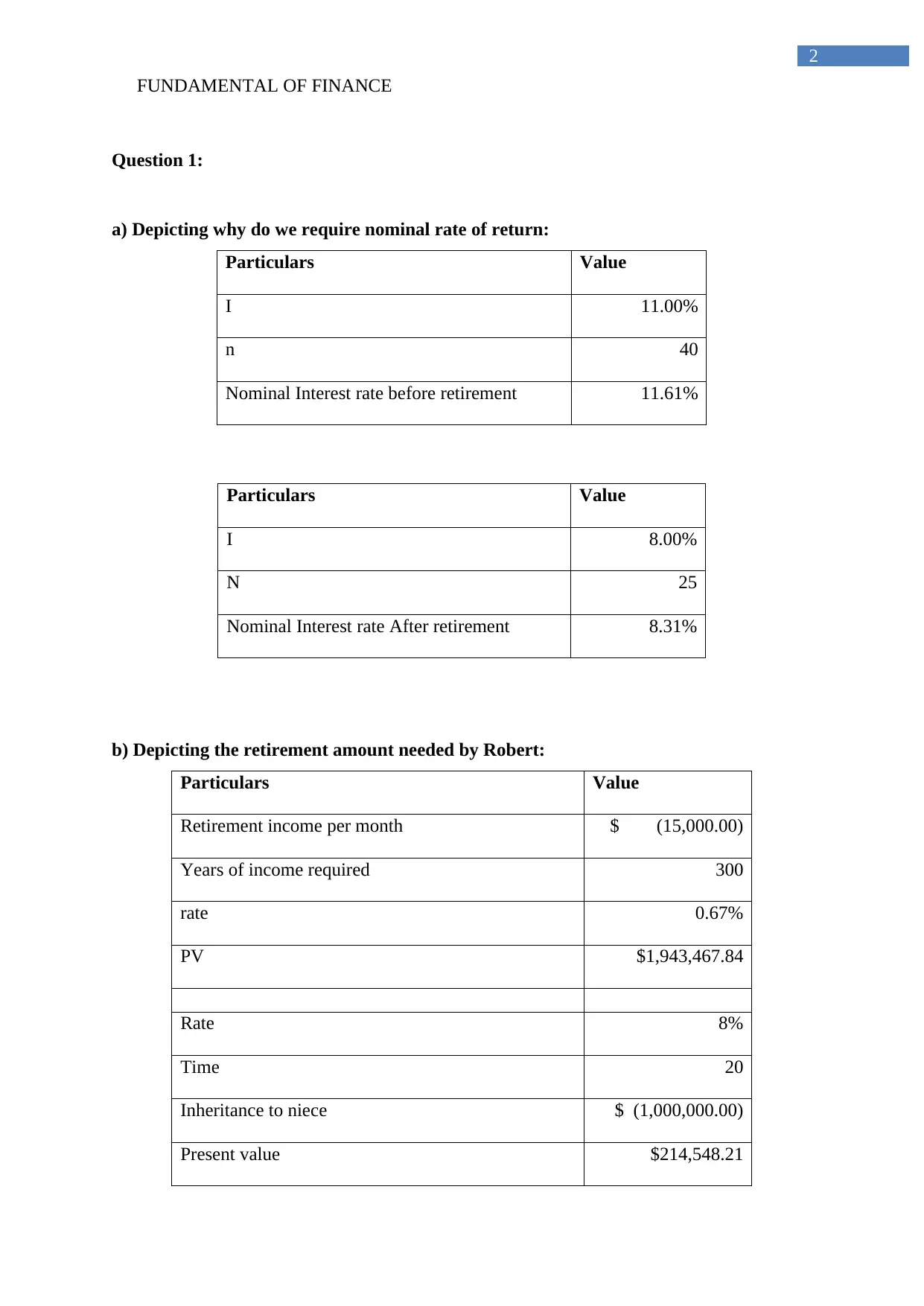
FUNDAMENTAL OF FINANCE
2
Question 1:
a) Depicting why do we require nominal rate of return:
Particulars Value
I 11.00%
n 40
Nominal Interest rate before retirement 11.61%
Particulars Value
I 8.00%
N 25
Nominal Interest rate After retirement 8.31%
b) Depicting the retirement amount needed by Robert:
Particulars Value
Retirement income per month $ (15,000.00)
Years of income required 300
rate 0.67%
PV $1,943,467.84
Rate 8%
Time 20
Inheritance to niece $ (1,000,000.00)
Present value $214,548.21
2
Question 1:
a) Depicting why do we require nominal rate of return:
Particulars Value
I 11.00%
n 40
Nominal Interest rate before retirement 11.61%
Particulars Value
I 8.00%
N 25
Nominal Interest rate After retirement 8.31%
b) Depicting the retirement amount needed by Robert:
Particulars Value
Retirement income per month $ (15,000.00)
Years of income required 300
rate 0.67%
PV $1,943,467.84
Rate 8%
Time 20
Inheritance to niece $ (1,000,000.00)
Present value $214,548.21
⊘ This is a preview!⊘
Do you want full access?
Subscribe today to unlock all pages.

Trusted by 1+ million students worldwide

FUNDAMENTAL OF FINANCE
3
Total PV $ 2,158,016.05
c) Estimating the value of apartment in 10 years:
Particulars Value
Purchase of Port Douglas in years 10
Value of the apartment $ 200,000
Growth rate 5.50%
Value of the apartment in 10 years $ 341,628.89
d) If the property is purchased then how much money is left over for his retirement:
Particulars Value
N 120
I 0.9%
PMT (2,000)
Future value $ 433,996.28
Withdrawals $ 341,628.89
Amount left after purchase $ 92,367.39
e) Depicting whether the remainder be sufficient to cover his retirement:
Particulars Value
N 480
I 0.9%
PMT (2,000)
3
Total PV $ 2,158,016.05
c) Estimating the value of apartment in 10 years:
Particulars Value
Purchase of Port Douglas in years 10
Value of the apartment $ 200,000
Growth rate 5.50%
Value of the apartment in 10 years $ 341,628.89
d) If the property is purchased then how much money is left over for his retirement:
Particulars Value
N 120
I 0.9%
PMT (2,000)
Future value $ 433,996.28
Withdrawals $ 341,628.89
Amount left after purchase $ 92,367.39
e) Depicting whether the remainder be sufficient to cover his retirement:
Particulars Value
N 480
I 0.9%
PMT (2,000)
Paraphrase This Document
Need a fresh take? Get an instant paraphrase of this document with our AI Paraphraser
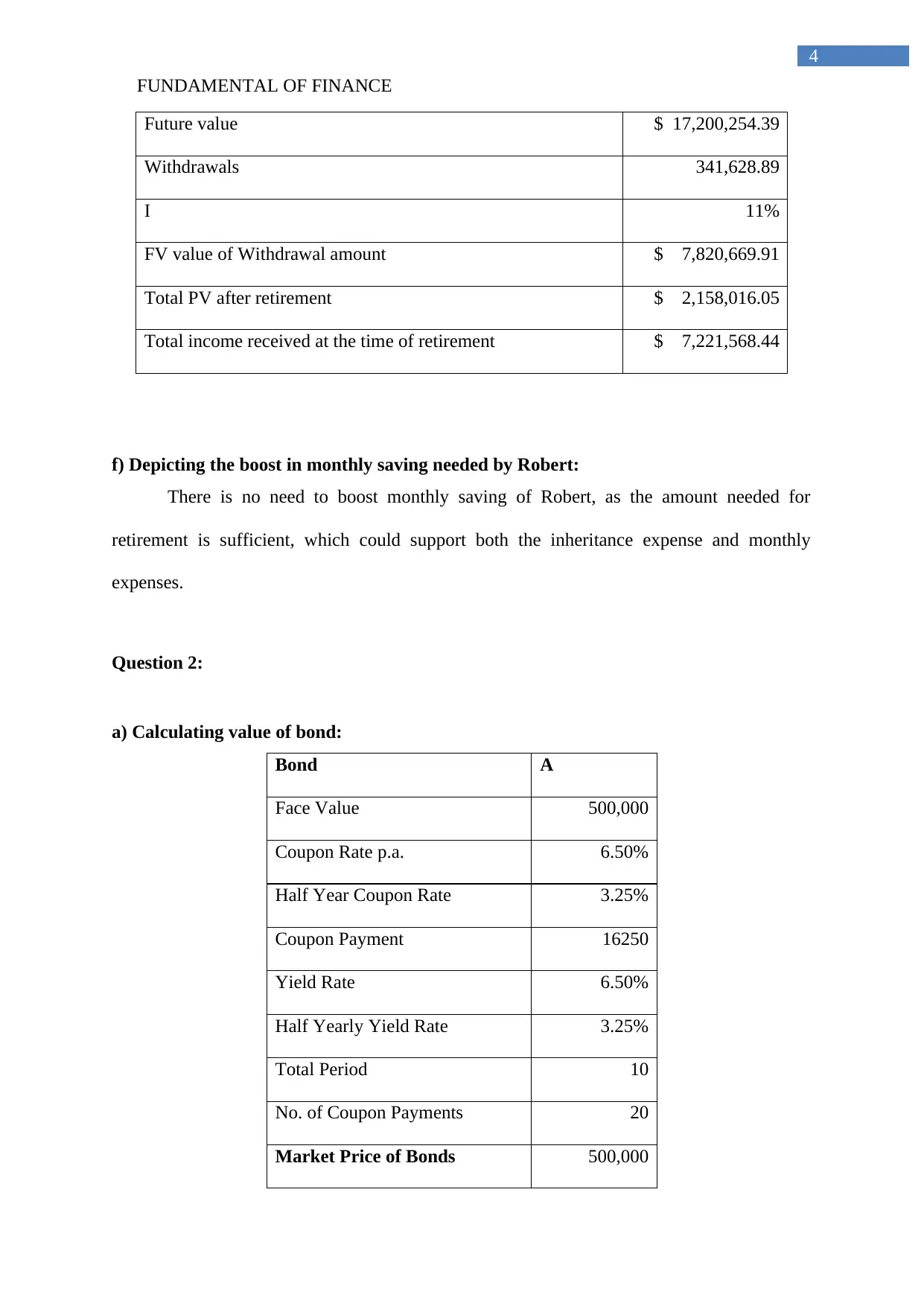
FUNDAMENTAL OF FINANCE
4
Future value $ 17,200,254.39
Withdrawals 341,628.89
I 11%
FV value of Withdrawal amount $ 7,820,669.91
Total PV after retirement $ 2,158,016.05
Total income received at the time of retirement $ 7,221,568.44
f) Depicting the boost in monthly saving needed by Robert:
There is no need to boost monthly saving of Robert, as the amount needed for
retirement is sufficient, which could support both the inheritance expense and monthly
expenses.
Question 2:
a) Calculating value of bond:
Bond A
Face Value 500,000
Coupon Rate p.a. 6.50%
Half Year Coupon Rate 3.25%
Coupon Payment 16250
Yield Rate 6.50%
Half Yearly Yield Rate 3.25%
Total Period 10
No. of Coupon Payments 20
Market Price of Bonds 500,000
4
Future value $ 17,200,254.39
Withdrawals 341,628.89
I 11%
FV value of Withdrawal amount $ 7,820,669.91
Total PV after retirement $ 2,158,016.05
Total income received at the time of retirement $ 7,221,568.44
f) Depicting the boost in monthly saving needed by Robert:
There is no need to boost monthly saving of Robert, as the amount needed for
retirement is sufficient, which could support both the inheritance expense and monthly
expenses.
Question 2:
a) Calculating value of bond:
Bond A
Face Value 500,000
Coupon Rate p.a. 6.50%
Half Year Coupon Rate 3.25%
Coupon Payment 16250
Yield Rate 6.50%
Half Yearly Yield Rate 3.25%
Total Period 10
No. of Coupon Payments 20
Market Price of Bonds 500,000
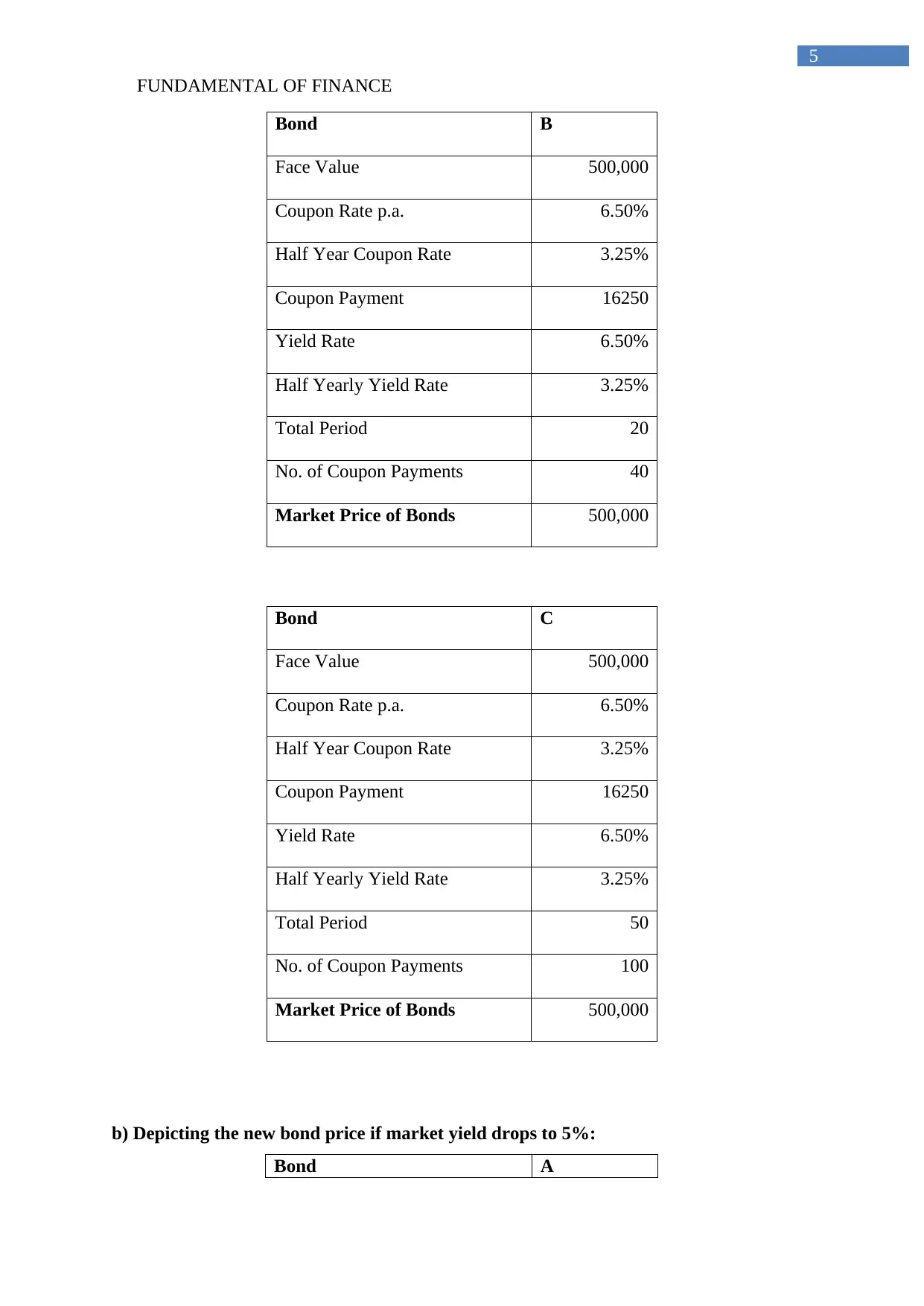
FUNDAMENTAL OF FINANCE
5
Bond B
Face Value 500,000
Coupon Rate p.a. 6.50%
Half Year Coupon Rate 3.25%
Coupon Payment 16250
Yield Rate 6.50%
Half Yearly Yield Rate 3.25%
Total Period 20
No. of Coupon Payments 40
Market Price of Bonds 500,000
Bond C
Face Value 500,000
Coupon Rate p.a. 6.50%
Half Year Coupon Rate 3.25%
Coupon Payment 16250
Yield Rate 6.50%
Half Yearly Yield Rate 3.25%
Total Period 50
No. of Coupon Payments 100
Market Price of Bonds 500,000
b) Depicting the new bond price if market yield drops to 5%:
Bond A
5
Bond B
Face Value 500,000
Coupon Rate p.a. 6.50%
Half Year Coupon Rate 3.25%
Coupon Payment 16250
Yield Rate 6.50%
Half Yearly Yield Rate 3.25%
Total Period 20
No. of Coupon Payments 40
Market Price of Bonds 500,000
Bond C
Face Value 500,000
Coupon Rate p.a. 6.50%
Half Year Coupon Rate 3.25%
Coupon Payment 16250
Yield Rate 6.50%
Half Yearly Yield Rate 3.25%
Total Period 50
No. of Coupon Payments 100
Market Price of Bonds 500,000
b) Depicting the new bond price if market yield drops to 5%:
Bond A
⊘ This is a preview!⊘
Do you want full access?
Subscribe today to unlock all pages.

Trusted by 1+ million students worldwide
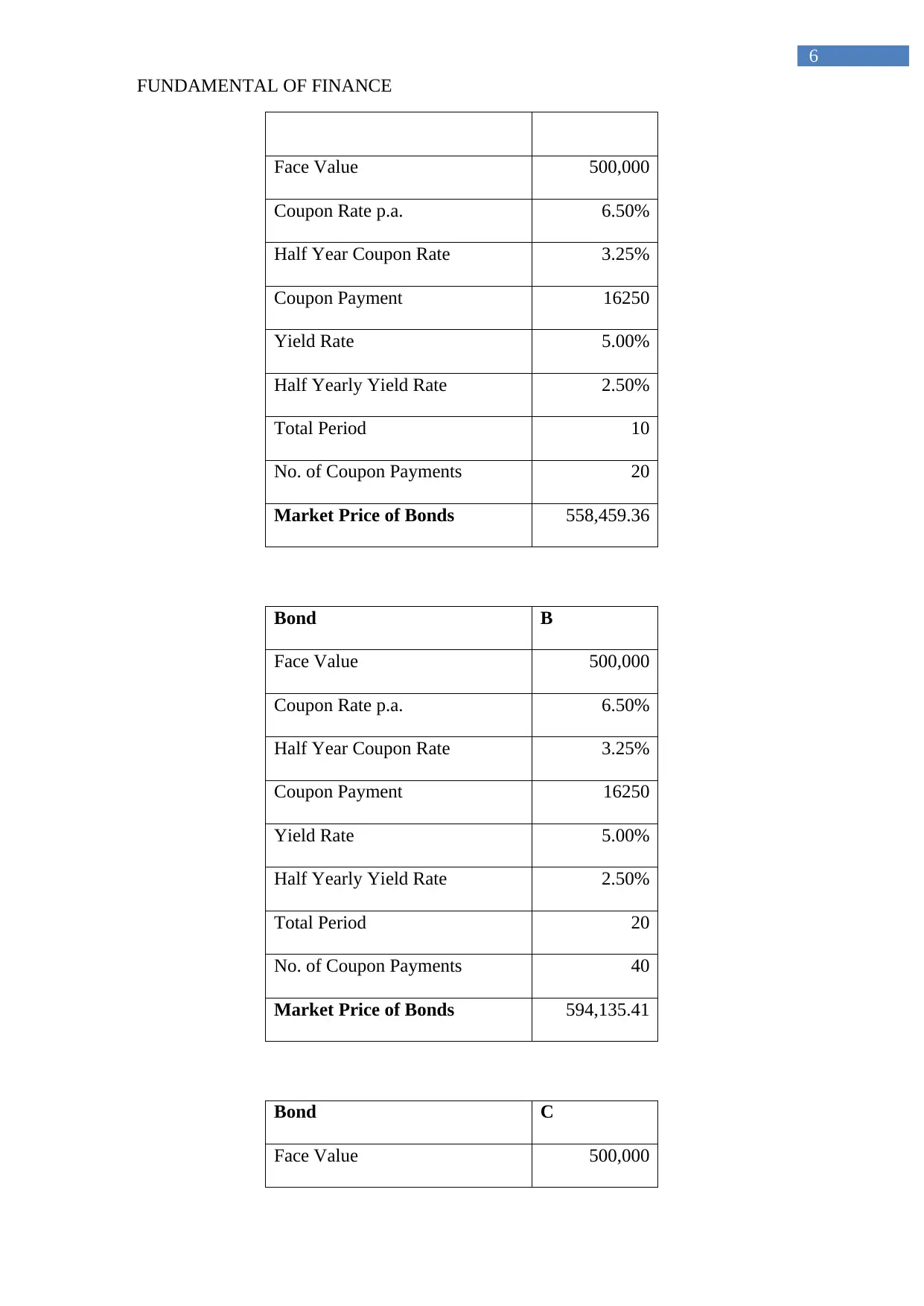
FUNDAMENTAL OF FINANCE
6
Face Value 500,000
Coupon Rate p.a. 6.50%
Half Year Coupon Rate 3.25%
Coupon Payment 16250
Yield Rate 5.00%
Half Yearly Yield Rate 2.50%
Total Period 10
No. of Coupon Payments 20
Market Price of Bonds 558,459.36
Bond B
Face Value 500,000
Coupon Rate p.a. 6.50%
Half Year Coupon Rate 3.25%
Coupon Payment 16250
Yield Rate 5.00%
Half Yearly Yield Rate 2.50%
Total Period 20
No. of Coupon Payments 40
Market Price of Bonds 594,135.41
Bond C
Face Value 500,000
6
Face Value 500,000
Coupon Rate p.a. 6.50%
Half Year Coupon Rate 3.25%
Coupon Payment 16250
Yield Rate 5.00%
Half Yearly Yield Rate 2.50%
Total Period 10
No. of Coupon Payments 20
Market Price of Bonds 558,459.36
Bond B
Face Value 500,000
Coupon Rate p.a. 6.50%
Half Year Coupon Rate 3.25%
Coupon Payment 16250
Yield Rate 5.00%
Half Yearly Yield Rate 2.50%
Total Period 20
No. of Coupon Payments 40
Market Price of Bonds 594,135.41
Bond C
Face Value 500,000
Paraphrase This Document
Need a fresh take? Get an instant paraphrase of this document with our AI Paraphraser
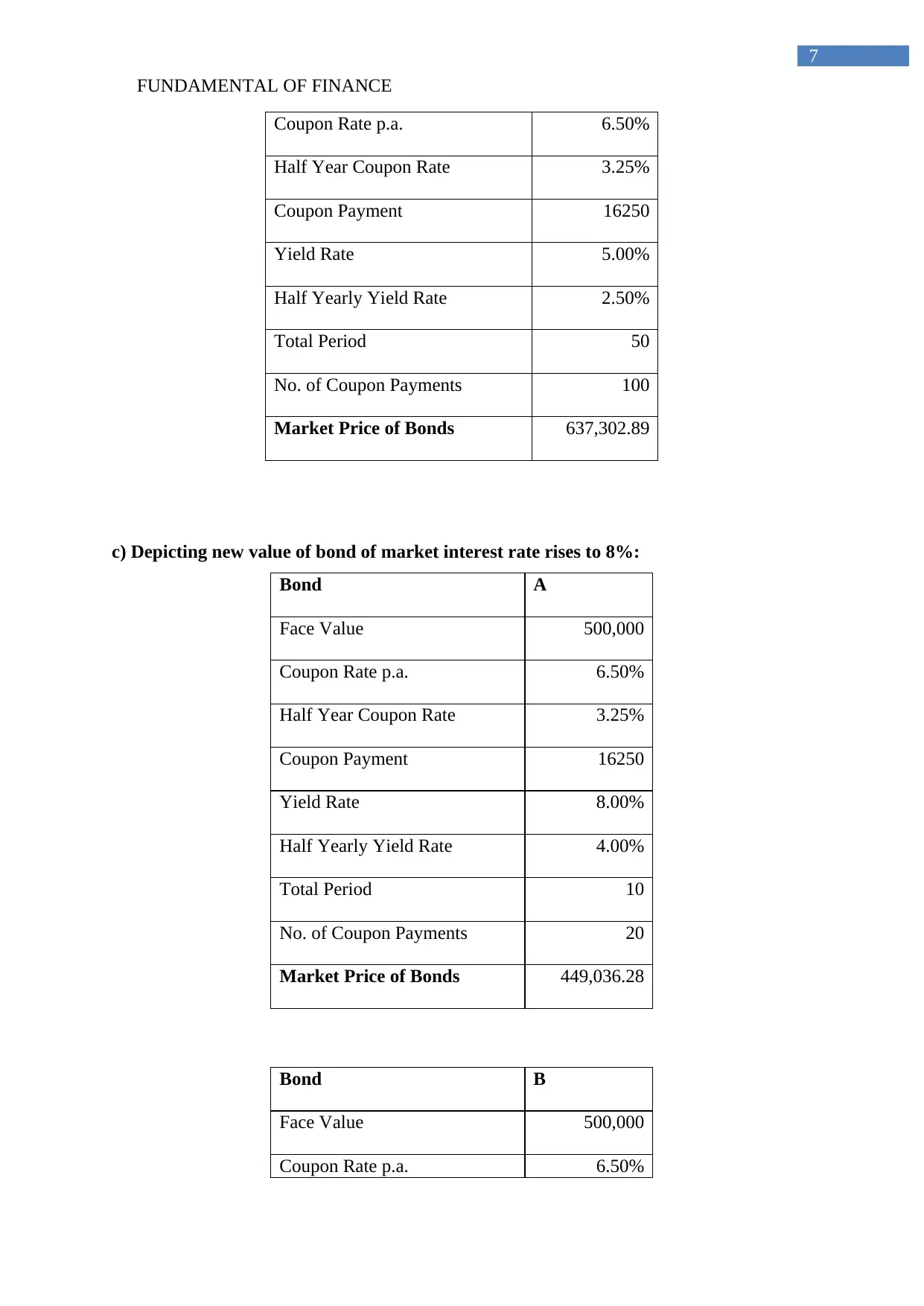
FUNDAMENTAL OF FINANCE
7
Coupon Rate p.a. 6.50%
Half Year Coupon Rate 3.25%
Coupon Payment 16250
Yield Rate 5.00%
Half Yearly Yield Rate 2.50%
Total Period 50
No. of Coupon Payments 100
Market Price of Bonds 637,302.89
c) Depicting new value of bond of market interest rate rises to 8%:
Bond A
Face Value 500,000
Coupon Rate p.a. 6.50%
Half Year Coupon Rate 3.25%
Coupon Payment 16250
Yield Rate 8.00%
Half Yearly Yield Rate 4.00%
Total Period 10
No. of Coupon Payments 20
Market Price of Bonds 449,036.28
Bond B
Face Value 500,000
Coupon Rate p.a. 6.50%
7
Coupon Rate p.a. 6.50%
Half Year Coupon Rate 3.25%
Coupon Payment 16250
Yield Rate 5.00%
Half Yearly Yield Rate 2.50%
Total Period 50
No. of Coupon Payments 100
Market Price of Bonds 637,302.89
c) Depicting new value of bond of market interest rate rises to 8%:
Bond A
Face Value 500,000
Coupon Rate p.a. 6.50%
Half Year Coupon Rate 3.25%
Coupon Payment 16250
Yield Rate 8.00%
Half Yearly Yield Rate 4.00%
Total Period 10
No. of Coupon Payments 20
Market Price of Bonds 449,036.28
Bond B
Face Value 500,000
Coupon Rate p.a. 6.50%
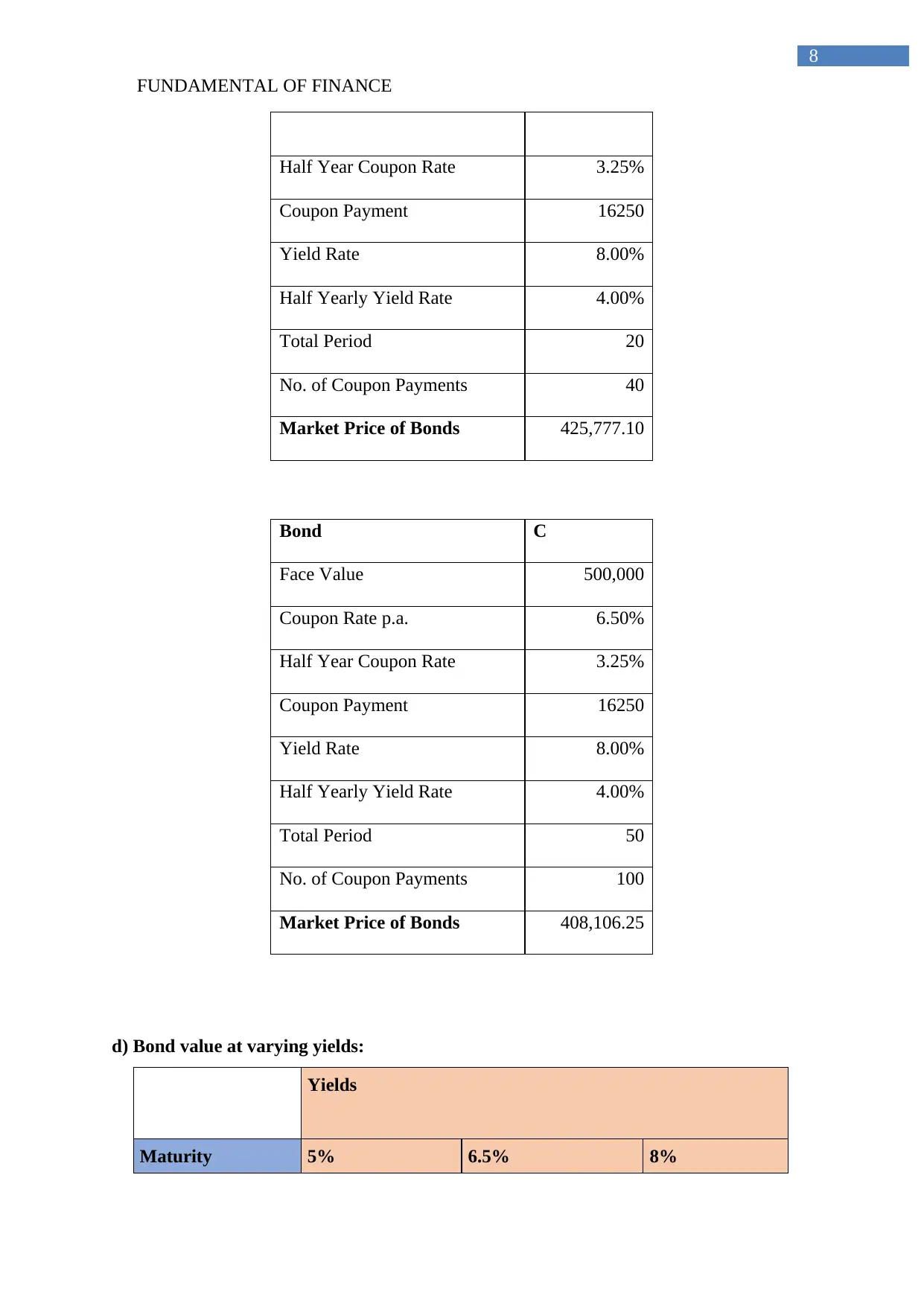
FUNDAMENTAL OF FINANCE
8
Half Year Coupon Rate 3.25%
Coupon Payment 16250
Yield Rate 8.00%
Half Yearly Yield Rate 4.00%
Total Period 20
No. of Coupon Payments 40
Market Price of Bonds 425,777.10
Bond C
Face Value 500,000
Coupon Rate p.a. 6.50%
Half Year Coupon Rate 3.25%
Coupon Payment 16250
Yield Rate 8.00%
Half Yearly Yield Rate 4.00%
Total Period 50
No. of Coupon Payments 100
Market Price of Bonds 408,106.25
d) Bond value at varying yields:
Yields
Maturity 5% 6.5% 8%
8
Half Year Coupon Rate 3.25%
Coupon Payment 16250
Yield Rate 8.00%
Half Yearly Yield Rate 4.00%
Total Period 20
No. of Coupon Payments 40
Market Price of Bonds 425,777.10
Bond C
Face Value 500,000
Coupon Rate p.a. 6.50%
Half Year Coupon Rate 3.25%
Coupon Payment 16250
Yield Rate 8.00%
Half Yearly Yield Rate 4.00%
Total Period 50
No. of Coupon Payments 100
Market Price of Bonds 408,106.25
d) Bond value at varying yields:
Yields
Maturity 5% 6.5% 8%
⊘ This is a preview!⊘
Do you want full access?
Subscribe today to unlock all pages.

Trusted by 1+ million students worldwide
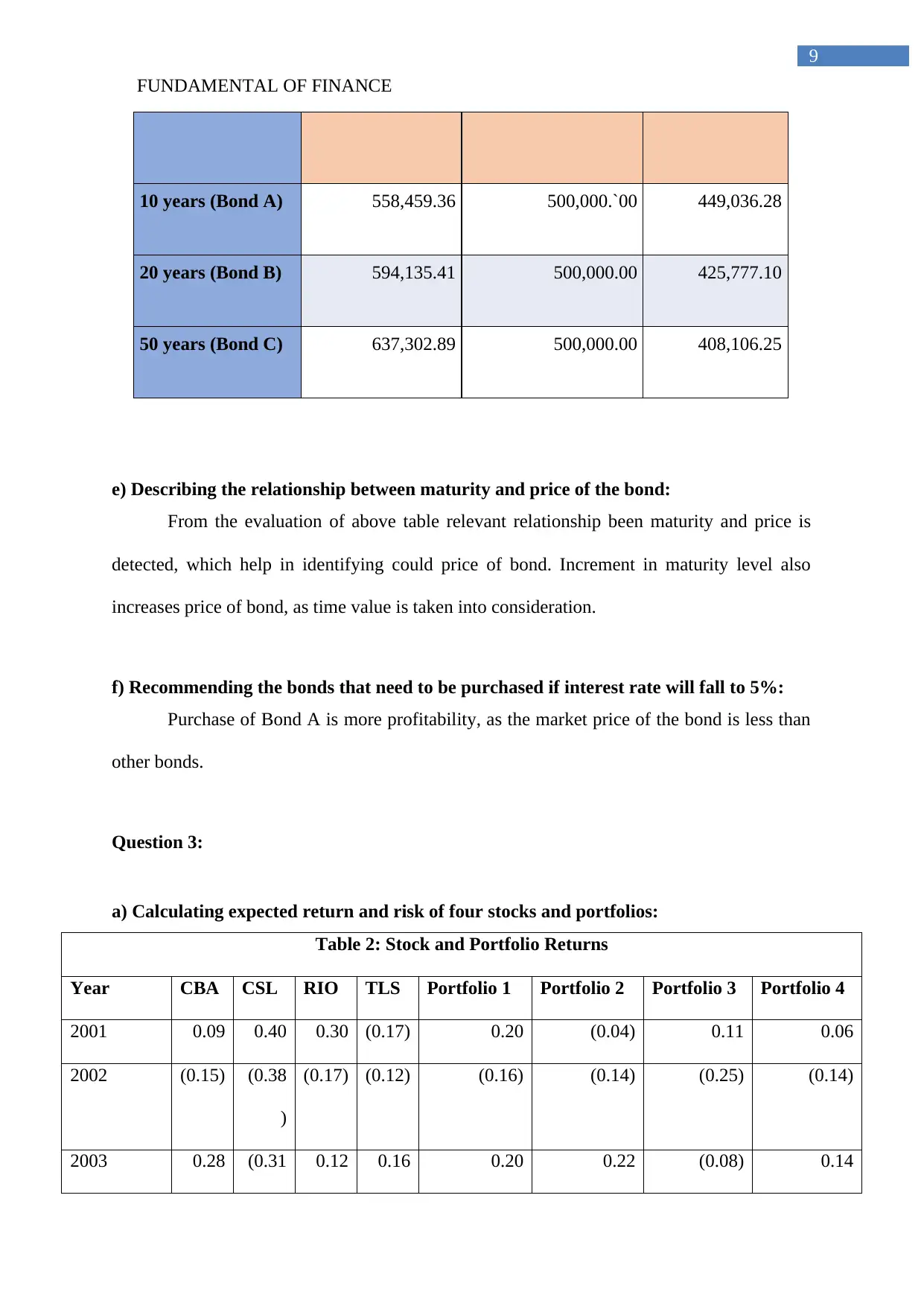
FUNDAMENTAL OF FINANCE
9
10 years (Bond A) 558,459.36 500,000.`00 449,036.28
20 years (Bond B) 594,135.41 500,000.00 425,777.10
50 years (Bond C) 637,302.89 500,000.00 408,106.25
e) Describing the relationship between maturity and price of the bond:
From the evaluation of above table relevant relationship been maturity and price is
detected, which help in identifying could price of bond. Increment in maturity level also
increases price of bond, as time value is taken into consideration.
f) Recommending the bonds that need to be purchased if interest rate will fall to 5%:
Purchase of Bond A is more profitability, as the market price of the bond is less than
other bonds.
Question 3:
a) Calculating expected return and risk of four stocks and portfolios:
Table 2: Stock and Portfolio Returns
Year CBA CSL RIO TLS Portfolio 1 Portfolio 2 Portfolio 3 Portfolio 4
2001 0.09 0.40 0.30 (0.17) 0.20 (0.04) 0.11 0.06
2002 (0.15) (0.38
)
(0.17) (0.12) (0.16) (0.14) (0.25) (0.14)
2003 0.28 (0.31 0.12 0.16 0.20 0.22 (0.08) 0.14
9
10 years (Bond A) 558,459.36 500,000.`00 449,036.28
20 years (Bond B) 594,135.41 500,000.00 425,777.10
50 years (Bond C) 637,302.89 500,000.00 408,106.25
e) Describing the relationship between maturity and price of the bond:
From the evaluation of above table relevant relationship been maturity and price is
detected, which help in identifying could price of bond. Increment in maturity level also
increases price of bond, as time value is taken into consideration.
f) Recommending the bonds that need to be purchased if interest rate will fall to 5%:
Purchase of Bond A is more profitability, as the market price of the bond is less than
other bonds.
Question 3:
a) Calculating expected return and risk of four stocks and portfolios:
Table 2: Stock and Portfolio Returns
Year CBA CSL RIO TLS Portfolio 1 Portfolio 2 Portfolio 3 Portfolio 4
2001 0.09 0.40 0.30 (0.17) 0.20 (0.04) 0.11 0.06
2002 (0.15) (0.38
)
(0.17) (0.12) (0.16) (0.14) (0.25) (0.14)
2003 0.28 (0.31 0.12 0.16 0.20 0.22 (0.08) 0.14
Paraphrase This Document
Need a fresh take? Get an instant paraphrase of this document with our AI Paraphraser
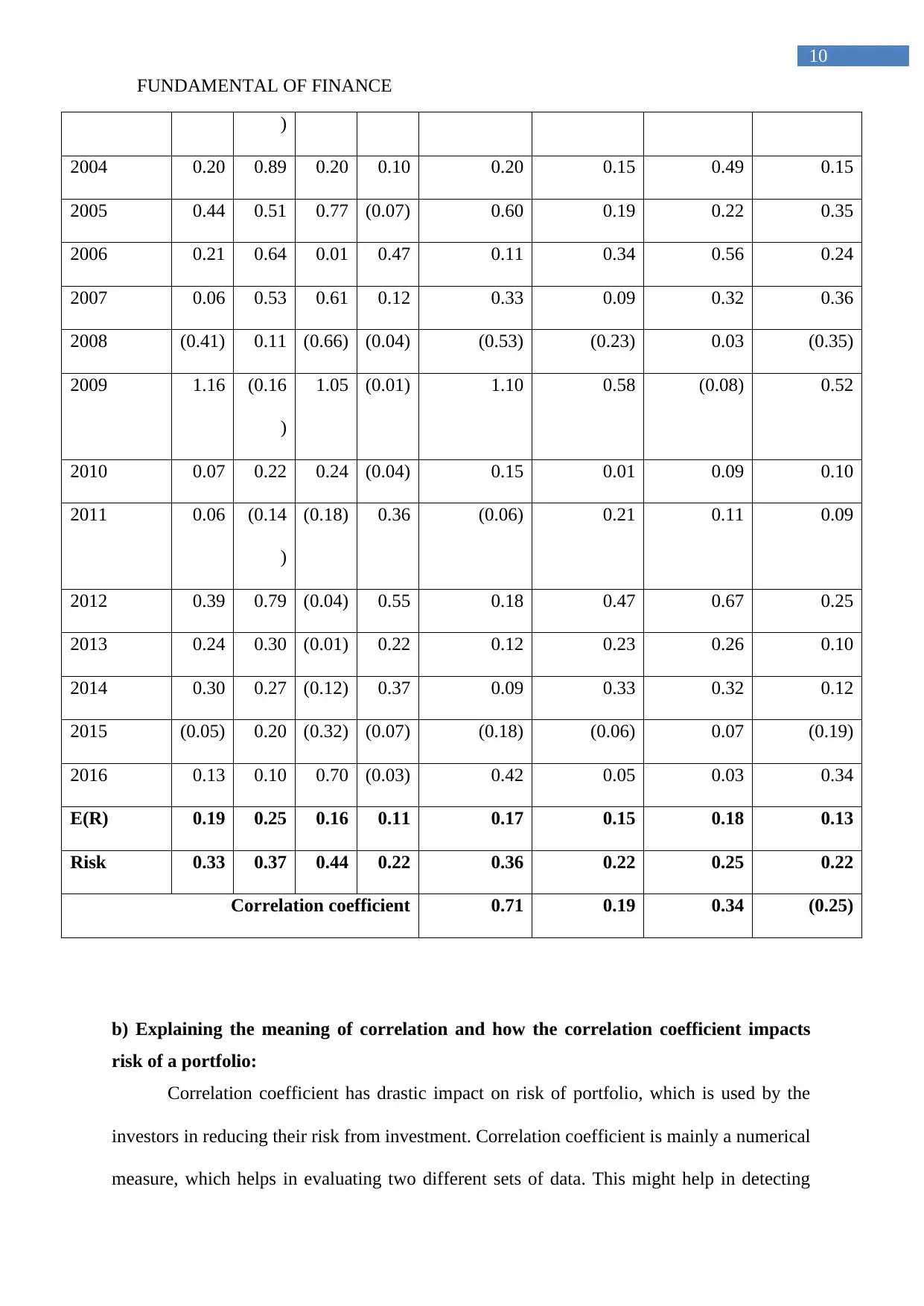
FUNDAMENTAL OF FINANCE
10
)
2004 0.20 0.89 0.20 0.10 0.20 0.15 0.49 0.15
2005 0.44 0.51 0.77 (0.07) 0.60 0.19 0.22 0.35
2006 0.21 0.64 0.01 0.47 0.11 0.34 0.56 0.24
2007 0.06 0.53 0.61 0.12 0.33 0.09 0.32 0.36
2008 (0.41) 0.11 (0.66) (0.04) (0.53) (0.23) 0.03 (0.35)
2009 1.16 (0.16
)
1.05 (0.01) 1.10 0.58 (0.08) 0.52
2010 0.07 0.22 0.24 (0.04) 0.15 0.01 0.09 0.10
2011 0.06 (0.14
)
(0.18) 0.36 (0.06) 0.21 0.11 0.09
2012 0.39 0.79 (0.04) 0.55 0.18 0.47 0.67 0.25
2013 0.24 0.30 (0.01) 0.22 0.12 0.23 0.26 0.10
2014 0.30 0.27 (0.12) 0.37 0.09 0.33 0.32 0.12
2015 (0.05) 0.20 (0.32) (0.07) (0.18) (0.06) 0.07 (0.19)
2016 0.13 0.10 0.70 (0.03) 0.42 0.05 0.03 0.34
E(R) 0.19 0.25 0.16 0.11 0.17 0.15 0.18 0.13
Risk 0.33 0.37 0.44 0.22 0.36 0.22 0.25 0.22
Correlation coefficient 0.71 0.19 0.34 (0.25)
b) Explaining the meaning of correlation and how the correlation coefficient impacts
risk of a portfolio:
Correlation coefficient has drastic impact on risk of portfolio, which is used by the
investors in reducing their risk from investment. Correlation coefficient is mainly a numerical
measure, which helps in evaluating two different sets of data. This might help in detecting
10
)
2004 0.20 0.89 0.20 0.10 0.20 0.15 0.49 0.15
2005 0.44 0.51 0.77 (0.07) 0.60 0.19 0.22 0.35
2006 0.21 0.64 0.01 0.47 0.11 0.34 0.56 0.24
2007 0.06 0.53 0.61 0.12 0.33 0.09 0.32 0.36
2008 (0.41) 0.11 (0.66) (0.04) (0.53) (0.23) 0.03 (0.35)
2009 1.16 (0.16
)
1.05 (0.01) 1.10 0.58 (0.08) 0.52
2010 0.07 0.22 0.24 (0.04) 0.15 0.01 0.09 0.10
2011 0.06 (0.14
)
(0.18) 0.36 (0.06) 0.21 0.11 0.09
2012 0.39 0.79 (0.04) 0.55 0.18 0.47 0.67 0.25
2013 0.24 0.30 (0.01) 0.22 0.12 0.23 0.26 0.10
2014 0.30 0.27 (0.12) 0.37 0.09 0.33 0.32 0.12
2015 (0.05) 0.20 (0.32) (0.07) (0.18) (0.06) 0.07 (0.19)
2016 0.13 0.10 0.70 (0.03) 0.42 0.05 0.03 0.34
E(R) 0.19 0.25 0.16 0.11 0.17 0.15 0.18 0.13
Risk 0.33 0.37 0.44 0.22 0.36 0.22 0.25 0.22
Correlation coefficient 0.71 0.19 0.34 (0.25)
b) Explaining the meaning of correlation and how the correlation coefficient impacts
risk of a portfolio:
Correlation coefficient has drastic impact on risk of portfolio, which is used by the
investors in reducing their risk from investment. Correlation coefficient is mainly a numerical
measure, which helps in evaluating two different sets of data. This might help in detecting
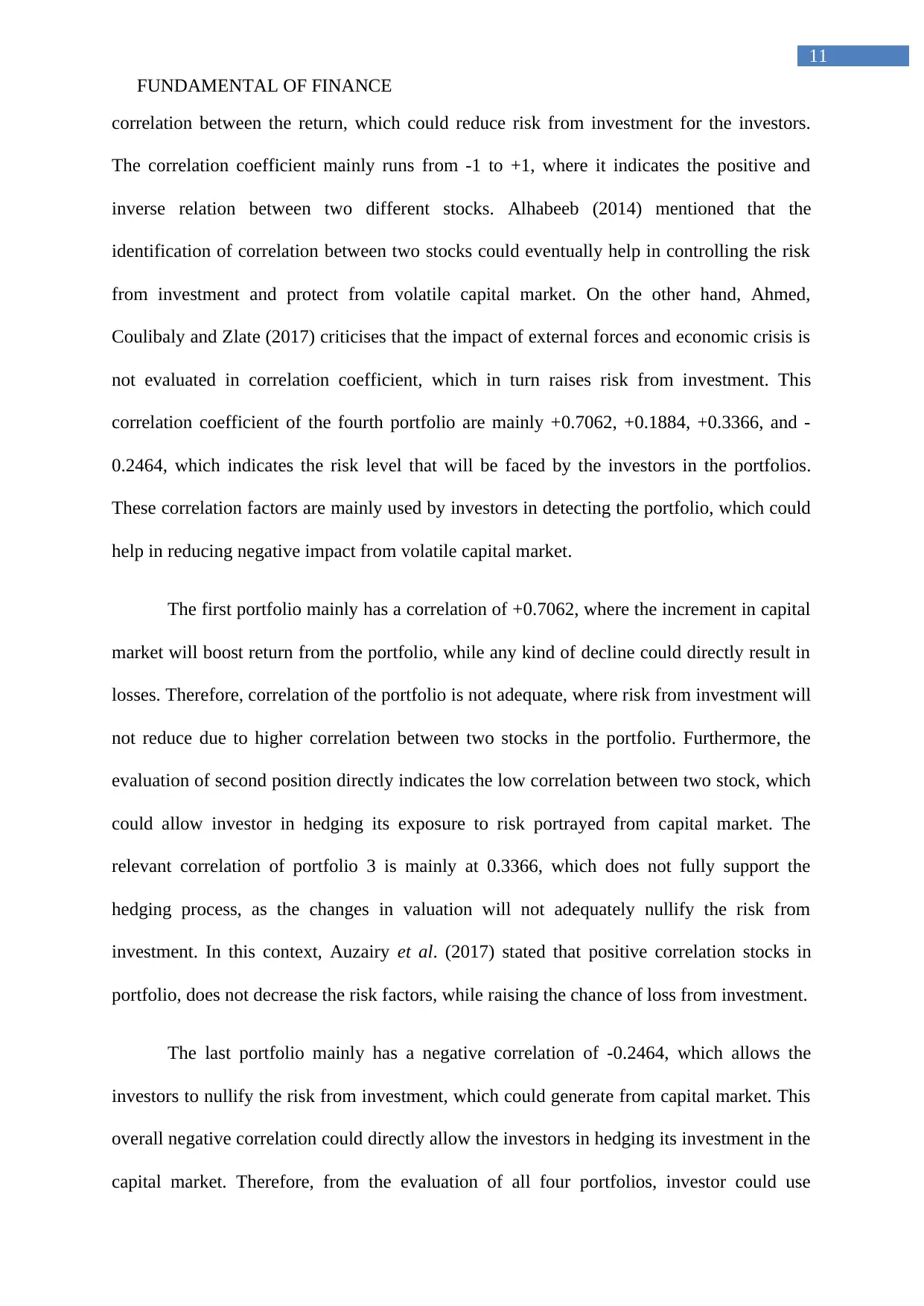
FUNDAMENTAL OF FINANCE
11
correlation between the return, which could reduce risk from investment for the investors.
The correlation coefficient mainly runs from -1 to +1, where it indicates the positive and
inverse relation between two different stocks. Alhabeeb (2014) mentioned that the
identification of correlation between two stocks could eventually help in controlling the risk
from investment and protect from volatile capital market. On the other hand, Ahmed,
Coulibaly and Zlate (2017) criticises that the impact of external forces and economic crisis is
not evaluated in correlation coefficient, which in turn raises risk from investment. This
correlation coefficient of the fourth portfolio are mainly +0.7062, +0.1884, +0.3366, and -
0.2464, which indicates the risk level that will be faced by the investors in the portfolios.
These correlation factors are mainly used by investors in detecting the portfolio, which could
help in reducing negative impact from volatile capital market.
The first portfolio mainly has a correlation of +0.7062, where the increment in capital
market will boost return from the portfolio, while any kind of decline could directly result in
losses. Therefore, correlation of the portfolio is not adequate, where risk from investment will
not reduce due to higher correlation between two stocks in the portfolio. Furthermore, the
evaluation of second position directly indicates the low correlation between two stock, which
could allow investor in hedging its exposure to risk portrayed from capital market. The
relevant correlation of portfolio 3 is mainly at 0.3366, which does not fully support the
hedging process, as the changes in valuation will not adequately nullify the risk from
investment. In this context, Auzairy et al. (2017) stated that positive correlation stocks in
portfolio, does not decrease the risk factors, while raising the chance of loss from investment.
The last portfolio mainly has a negative correlation of -0.2464, which allows the
investors to nullify the risk from investment, which could generate from capital market. This
overall negative correlation could directly allow the investors in hedging its investment in the
capital market. Therefore, from the evaluation of all four portfolios, investor could use
11
correlation between the return, which could reduce risk from investment for the investors.
The correlation coefficient mainly runs from -1 to +1, where it indicates the positive and
inverse relation between two different stocks. Alhabeeb (2014) mentioned that the
identification of correlation between two stocks could eventually help in controlling the risk
from investment and protect from volatile capital market. On the other hand, Ahmed,
Coulibaly and Zlate (2017) criticises that the impact of external forces and economic crisis is
not evaluated in correlation coefficient, which in turn raises risk from investment. This
correlation coefficient of the fourth portfolio are mainly +0.7062, +0.1884, +0.3366, and -
0.2464, which indicates the risk level that will be faced by the investors in the portfolios.
These correlation factors are mainly used by investors in detecting the portfolio, which could
help in reducing negative impact from volatile capital market.
The first portfolio mainly has a correlation of +0.7062, where the increment in capital
market will boost return from the portfolio, while any kind of decline could directly result in
losses. Therefore, correlation of the portfolio is not adequate, where risk from investment will
not reduce due to higher correlation between two stocks in the portfolio. Furthermore, the
evaluation of second position directly indicates the low correlation between two stock, which
could allow investor in hedging its exposure to risk portrayed from capital market. The
relevant correlation of portfolio 3 is mainly at 0.3366, which does not fully support the
hedging process, as the changes in valuation will not adequately nullify the risk from
investment. In this context, Auzairy et al. (2017) stated that positive correlation stocks in
portfolio, does not decrease the risk factors, while raising the chance of loss from investment.
The last portfolio mainly has a negative correlation of -0.2464, which allows the
investors to nullify the risk from investment, which could generate from capital market. This
overall negative correlation could directly allow the investors in hedging its investment in the
capital market. Therefore, from the evaluation of all four portfolios, investor could use
⊘ This is a preview!⊘
Do you want full access?
Subscribe today to unlock all pages.

Trusted by 1+ million students worldwide
1 out of 14
Related Documents
Your All-in-One AI-Powered Toolkit for Academic Success.
+13062052269
info@desklib.com
Available 24*7 on WhatsApp / Email
![[object Object]](/_next/static/media/star-bottom.7253800d.svg)
Unlock your academic potential
Copyright © 2020–2025 A2Z Services. All Rights Reserved. Developed and managed by ZUCOL.



![Assignment 2: Financial Plan for Allen Family - [University Name]](/_next/image/?url=https%3A%2F%2Fdesklib.com%2Fmedia%2Fimages%2Fqc%2F6af4f680480942c1a286e877fbe6432e.jpg&w=256&q=75)
